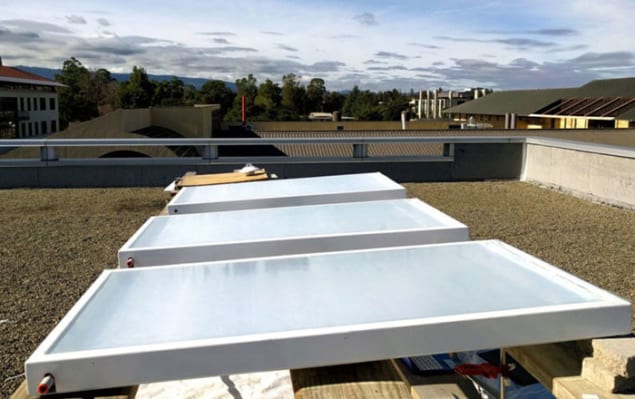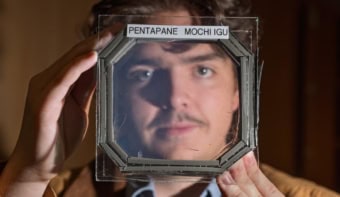
With about 15% of the world’s electricity used for cooling, making air-conditioning systems more efficient could go a long way to ease future energy demand. A group of scientists in sunny California reckons it can do just that via “radiative cooling” – a process requiring essentially no external source of power that transmits unwanted heat into the cold of outer space via infrared emission. The researchers have shown that a device able to reflect almost all incoming radiation from the Sun while simultaneously emitting in the infrared could reduce electricity consumption from air conditioners by at least a fifth.
Objects emit electromagnetic radiation with a spectrum that peaks at a particular wavelength depending on the object’s temperature. Radiative cooling exploits the fact that the peak at room temperature lies in a narrow range of infrared wavelengths (8–13 μm) that pass through the Earth’s atmosphere with relatively little absorption. This allows an object placed outside with a clear view of the heavens to lose a significant fraction of its thermal energy to outer space, which, having a temperature of just 3 K, serves as an enormous heat sink.
This principle has been exploited for many years to cool buildings and other objects when it is dark. Objects are simply covered by a suitable layer of thermal insulation to ensure that the energy they emit into space is not counter-balanced by convection and conduction that would normally keep them in thermal equilibrium. In this way, they can be cooled by as much as 15° below ambient temperatures.
Hot stuff
Doing the same thing during the day, however – when cooling is most needed – has proved much harder. Most materials that readily emit radiation are also good absorbers of sunlight and the heat they lose to outer space tends to be heavily outweighed by the energy they absorb from the Sun. The trick is to find a material that is a good solar reflector but can also emit in the infrared. Metals such as silver, for example, meet the former condition but not the latter.
Three years ago, Shanhui Fan and colleagues at Stanford University showed it is in fact possible to have your cake and eat it. They developed a material just 1.8 μm thick, made from seven layers of silicon dioxide and hafnium oxide laid on top of sliver, which reflected 97% of the sunlight striking it while at the same time emitting the relevant portion of the infrared spectrum. By insulating the film using polyethylene, wood and air, and placing it on a roof in Stanford on a sunny winter’s day, the researchers found they could cool it to nearly 5° below the ambient temperature.
However, Fan says, developing the device itself is only part of the challenge. If the device is to be used to cool buildings, he points out that a mechanism is needed to “deliver the coldness from outside to inside”. Because many modern buildings are very well insulated, he says that simply cooling their roof will not do much to lower their internal temperature.
Cooling water
In the latest research, he and his colleagues instead exploit the fact that many buildings already contain air-conditioning systems. The idea, he explains, is to radiatively cool the water that is used in some large air conditioners to lower the temperature of the refrigerant condenser. To test the idea, Fan and co-workers swapped the silicon dioxide and hafnium oxide of their earlier device with an extruded copolymer – which has similar photonic properties but is easier to scale up – and then added a heat exchanger and an insulating enclosure to create a number of “cooling panels”, each around a third of a metre squared.
Returning to their Stanford rooftop, the researchers connected three of the panels together and pumped water through the heat exchangers. They found that for air temperatures of up to about 30°, they could cool the flowing water by between 3–5° – the upper end of the range, they say, equalling about 70 W of cooling power for every square metre of panel. Afterwards, they plugged those numbers into a model that simulated the air-conditioning system of a two-storey office building in hot and dry Las Vegas and calculated that the panels could reduce electrical consumption by 21%.
Fan and colleagues are not the only ones working on daytime radiative cooling. Earlier this year, a group at the University of Colorado Boulder reported an average cooling power of 110 W/m2 from a silver-backed polymer film containing silicon-dioxide balls made using a roll-to-roll process. But Colorado team member Xiaobo Yin praises the Stanford group for its “exciting progress” with the water-based demonstration, agreeing that the technology “can potentially be integrated with building air conditioning systems”.
“Good option”
According to Eli Yablonovitch at the University of California, Berkeley, radiative cooling could be competitive with solar energy. He explains that solar panels have a higher power density but only contribute energy for about a quarter of each day, whereas radiative devices could cool water continuously. For hot dry climates, he says, that could make them “a good option” as an energy-saving technology.
Fan acknowledges that his group must still overcome a number of hurdles before its devices can enter the market, including proving their reliability. But he and his two co-authors – Eli Goldstein and Aaswath Raman – have nevertheless set up a company known as Skycool Systems to commercialise the technology. As regards price, Raman is bullish, claiming that the devices will recover their costs in terms of lower electricity bills within “several years” of switching on.



